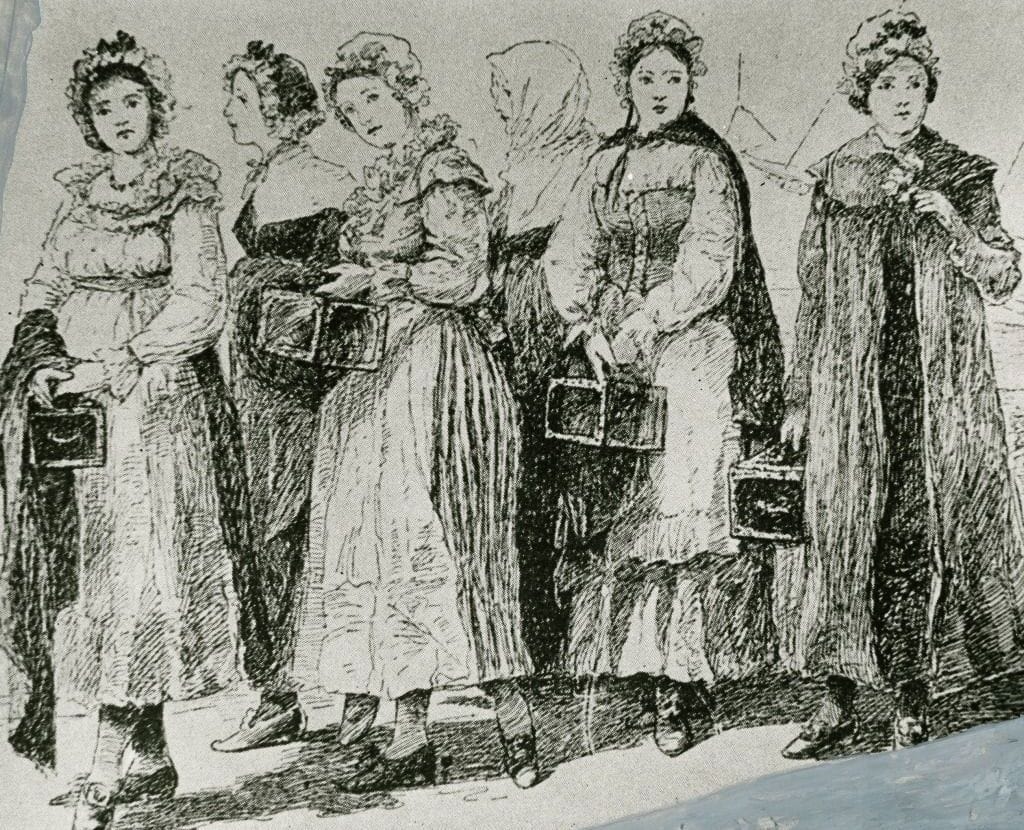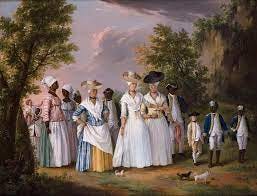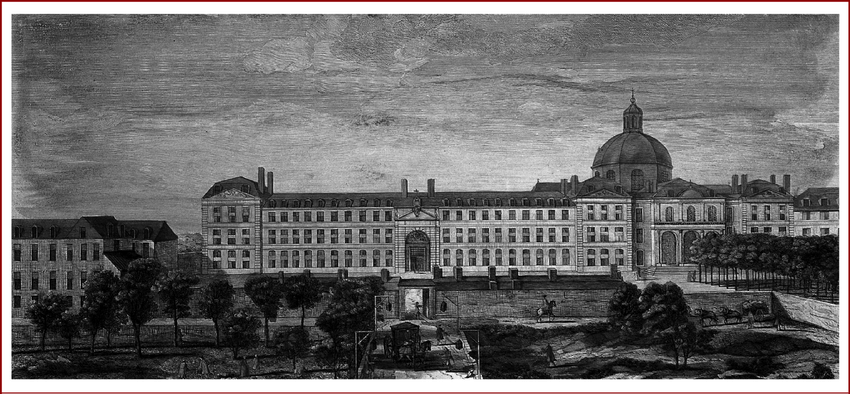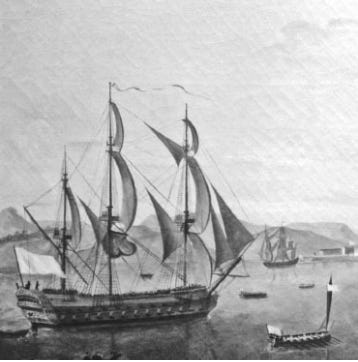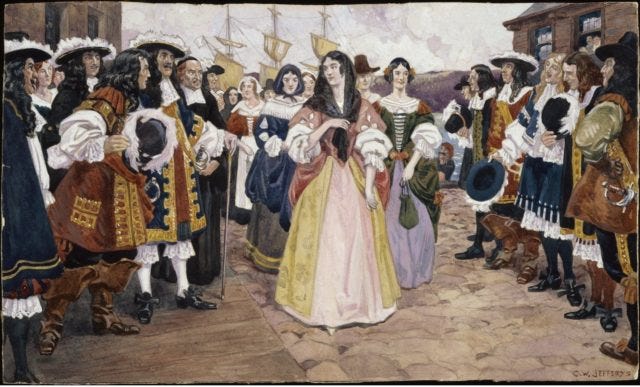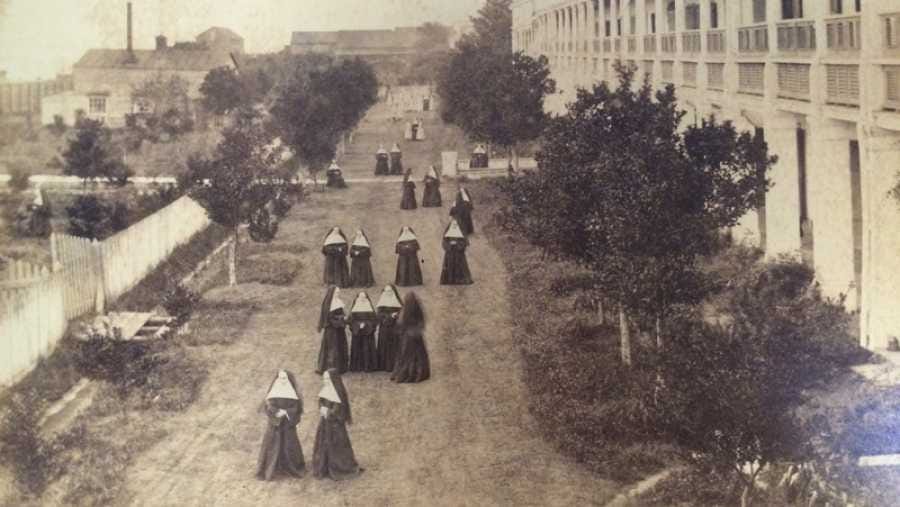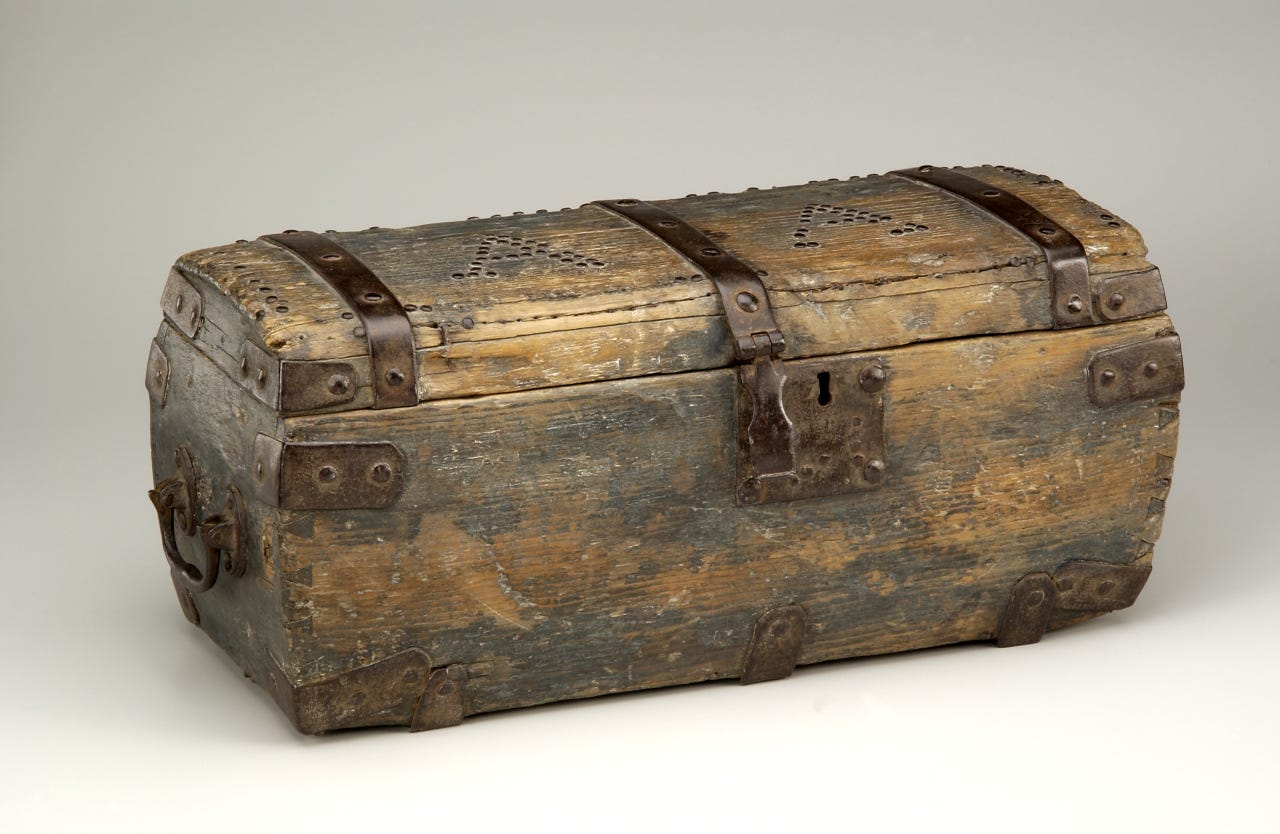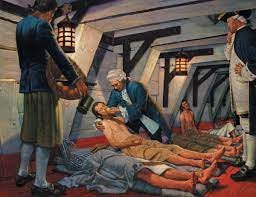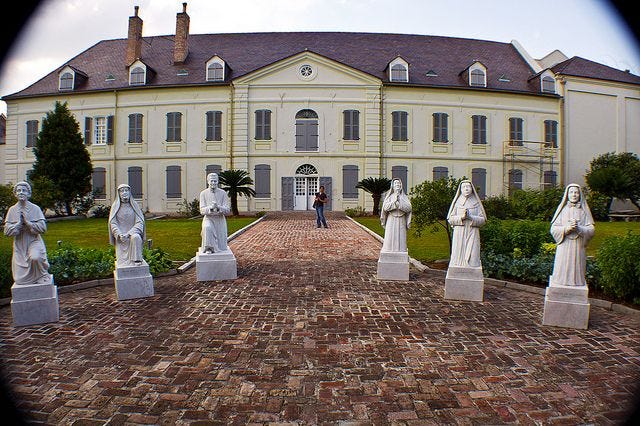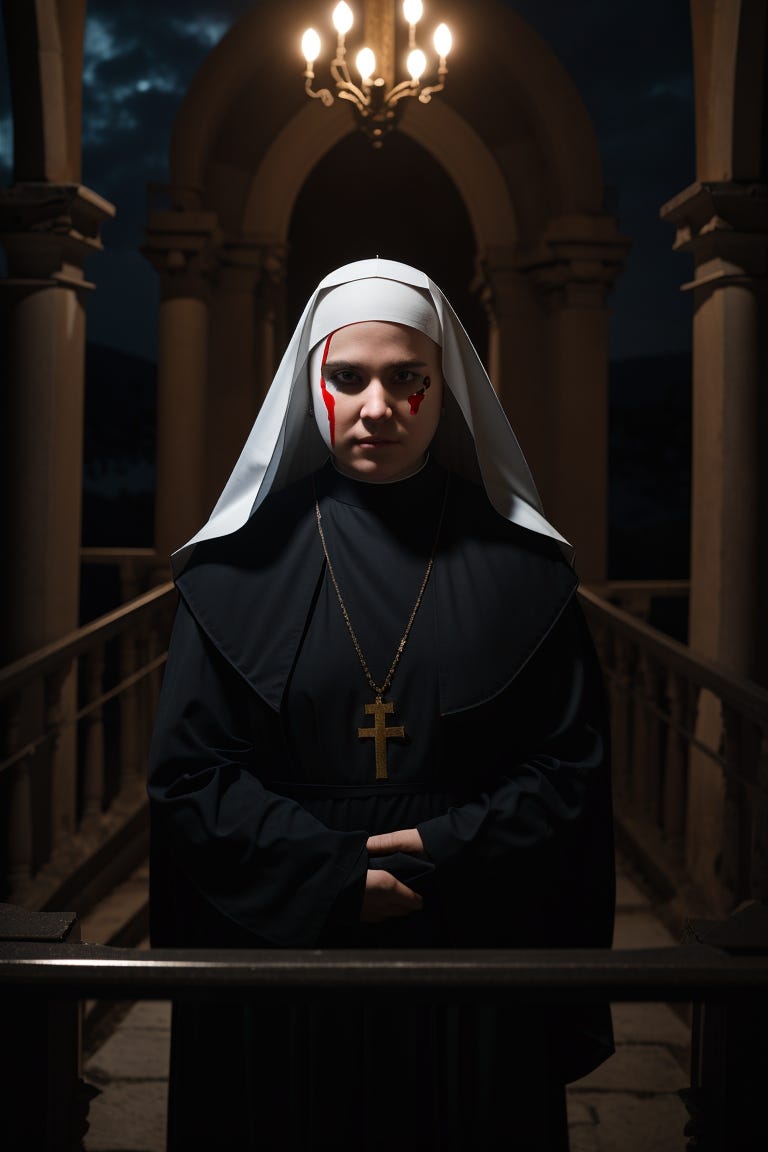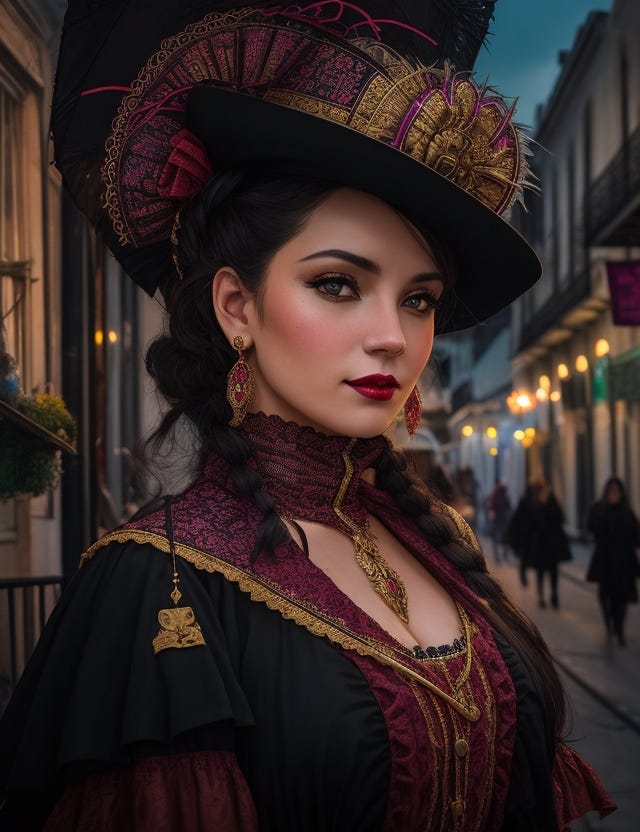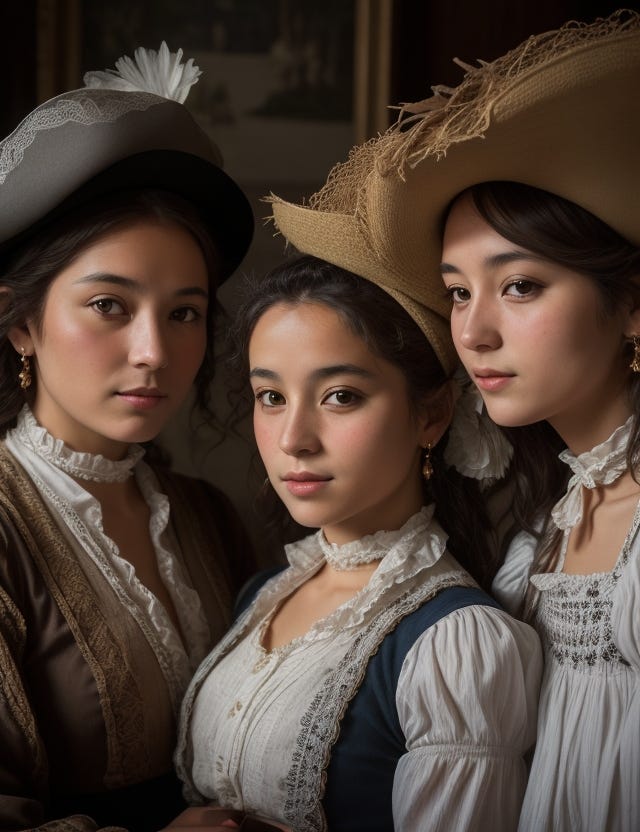The Haunting Mystery of New Orleans's Casket Girls
Legends, History, & Vampire Lore
Nestled beneath the moon's eerie glow and swaying Spanish moss in New Orleans, a tale as mysterious as the city itself begins to unfold: the legend of the Casket Girls. Echoing through the centuries, this story weaves a delicate blend of history and supernatural intrigue, drawing us into the hauntingly beautiful streets of the French Quarter.
The Origins of the Legend: Who Were the Casket Girls?
In 1727, a group of brave young women undertook a perilous journey across the Atlantic from France to the burgeoning colony of Louisiana. Known as les filles à la cassette, or Casket Girls, these women carried small chests, or “cassettes,” filled with their belongings. Their mission? To become the wives of Louisiana’s early settlers, helping to establish a new life in the rugged, untamed New World.
However, the legend suggests they brought more than just hope and trousseaus. According to New Orleans Vampires: History and Legend by Marita Woywood Cradle, these young women were rumored to be accompanied by something far more sinister. Whispers of vampires lurking among the passengers soon surfaced, preying on the weak and ill as the ship sailed across the stormy seas.
The Ursuline Nuns & Their Battle Against the Supernatural
The Casket Girls weren’t alone on their journey; they were under the protection of the Ursuline nuns, whose convent would soon become central to the story. These women of faith, armed only with their unshakeable beliefs, were said to confront these vampiric creatures, shielding the maidens from a fate worse than death. The nuns’ prayers and holy symbols clashed with the malevolent forces onboard, creating a supernatural showdown that left an indelible mark on the lore of New Orleans.
Once the ship finally reached the French Quarter, the Casket Girls sought refuge in the shadows of the Ursuline Convent. The convent’s iconic attic windows, sealed tight to this day, are often cited as evidence of this dark history—a silent reminder of the eerie events that once unfolded within its walls.
Separating Fact from Fiction: The Real Story of the Casket Girls
While the legend is exciting, it is crucial to take a step back and uncover the historical truth behind the Casket Girls. These women were indeed real. Courageously determined, they left everything they knew to venture into the unknown and help build a new society in Louisiana. Their story is rooted in the need to stabilize the colony, providing wives for the settlers in a place where men significantly outnumbered women.
The Ursuline Convent still stands as a living relic of this era. Its sealed attic windows fuel ghost stories and speculation. However, these windows have a practical explanation related to preservation and security rather than the supernatural. Nonetheless, the convent’s murky history and association with the Casket Girls keep the legend alive in the hearts of New Orleans residents and visitors alike.
As we delve deeper into the tale of the Casket Girls, we will continue to explore how history and legend have intertwined to create one of the city’s most enduring mysteries. With each step through the cobblestone streets of the French Quarter, the whispers of the past grow louder, beckoning us to uncover the truths hidden within the fog of time.
The Casket Girls & Their Role in Louisiana’s Troubled Population: A Dark Chapter in Colonial History
Now that we’ve established that the Casket Girls were indeed real, you might be wondering why colonial Louisiana needed them in the first place. After all, weren’t there already women in New Orleans? The answer lies in the colony’s unique and complex population challenges during the 18th century.
Louisiana’s Population Crisis: Why Women Were Key
In the early days of Louisiana’s settlement, the male population mainly consisted of adventurers, fur traders, and explorers—men attracted by the promise of wealth and new beginnings. However, the colony’s leaders had more practical ambitions. They envisioned a thriving society built on agriculture, trade, and community. To achieve this, they needed more than adventurous spirits; they needed stability. In the 18th century, women were seen as essential to creating that stability.
The original plan was straightforward: French settlers were encouraged to marry indigenous women, integrating them into French society. But history, as always, had its twists. Instead of transforming their new wives into proper French ladies, many male settlers embraced the relaxed communal lifestyle of their indigenous partners. This cultural blending, while beautiful, didn’t align with the rigid structure the colony’s leaders had envisioned.
The Search for Stability: Louisiana’s Female Penal Colony
With their initial plan faltering, Louisiana’s colonial leaders sought assistance from the French government. They looked to a successful initiative in New France (present-day Quebec), where the King had sponsored a program called les filles du roi, or the Daughters of the King. These women, sent to marry French settlers, were offered dowries and support, fostering the growth of New France's population.
However, Louisiana’s situation was far more desperate. Instead of noble or middle-class women like those in New France, the colony became a destination for women from some of the toughest areas of Paris. Louisiana effectively turned into a makeshift female penal colony. Overseen by John Law’s Western Company, the program was anything but selective. Women were frequently kidnapped from vulnerable circumstances, including orphans, the impoverished, and even prisoners.
Five shipments of women arrived in Louisiana between 1704 and 1721, but the outcomes were mixed. Many of these women endured severe hardships during their journey, including malnutrition and disease. Upon arrival, they faced additional challenges as they tried to adapt to the harsh conditions of a frontier colony.
The Casket Girls: The Final Shipment that Changed Everything
The Casket Girls were part of the last wave of women sent to Louisiana, arriving in 1727. Unlike earlier shipments, this group was more successful in bringing much-needed stability to the colony. They were called Casket Girls because they arrived with small chests, or cassettes, containing their belongings.
These women played a critical role in shaping the cultural and population centers of New Orleans, Biloxi, and Mobile. They lured their husbands out of the wilderness, promoted the development of trade and communities, and helped transform these fledgling settlements into thriving towns. Despite their hardships, the Casket Girls left a lasting mark on Louisiana’s history.
Their story powerfully reminds us of how a determined group of young women could alter the course of a colony’s future. From their arrival in the French Quarter to their role in stabilizing the population, the Casket Girls were much more than legends—they were essential figures in the formation of Louisiana as we know it today.
The Origins of the Casket Girls: From La Salpêtrière to Louisiana
Now that we’ve uncovered why the Casket Girls were sent to Louisiana let’s take a closer look at who these young women were. Contrary to what you might expect, they weren’t random girls picked off the streets of Paris. Their journey began in one of the most notorious institutions of 18th-century France: La Salpêtrière.
La Salpêtrière: A Shelter for Society’s Outcasts
La Salpêtrière was a sprawling institution in Paris, far more than just a hospital. It housed a diverse mix of women, from orphans to homeless individuals, and even prostitutes and convicted criminals. The facility was infamous for its harsh conditions, and it even included a prison called La Force, known for its cruelty. The Casket Girls were carefully chosen from this unique population—not for punishment, but for their potential to thrive in the New World.
These young women, known as filles du cassette (Girls of Suitcases), were selected for their virginity and strong character—traits that made them desirable in Louisiana’s marriage market. Handpicked from the orphans at La Salpêtrière, around two dozen girls aged 14 to 17 embarked on this life-changing journey. Each was given a small trunk, or cassette, filled with their trousseau. It’s from these small trunks that the name “Casket Girls” emerged, although it wasn’t until the 19th century that the term ‘casket” began to refer to a coffin.
Chaperones & a Surprising Destination: The Casket Girls’ Journey to Biloxi
The Casket Girls weren’t sent to this unfamiliar world alone. Accompanied by chaperones from La Salpêtrière, including Sister Gertrude and two other nuns, these young women had guardians to ensure their safety throughout the perilous voyage. However, here’s a twist you might not expect: the Casket Girls didn’t arrive in New Orleans, as many assume. Instead, their journey took them to Biloxi, in what is now modern-day Mississippi.
Their arrival wasn’t the grand entrance you might imagine. Upon landing, they were placed in temporary accommodations—likely warehouses—where they waited to meet their prospective husbands. It was a unique and unconventional form of matchmaking, far from the structured marriage arrangements we think of today.
Resilient Survivors: Defying the 18th-Century Mold
These young women were far from the meek and modest ladies society might have expected. Growing up in the harsh environment of La Salpêtrière, they became resilient survivors who developed the strength and determination needed to thrive in Louisiana’s frontier. Governor Bienville himself praised their purity and piety but also observed their unruly and independent behavior, which didn’t always align with the expectations of the time.
From a modern perspective, it’s clear why these women stood out. They were shaped by a tough environment and learned to survive in ways that challenged the norms of their era. Instead of being quiet, compliant brides, the Casket Girls infused their new homes with a spirit of resilience, helping lay the foundation for a stable and thriving colony.
The Treacherous Voyage of the Casket Girls: From France to Louisiana
Before the Casket Girls could start their new lives in Louisiana, they first had to survive the dangerous journey across the Atlantic. It was 1721, a period when transatlantic travel was an exhausting test of endurance. Forget about the comfort of modern air travel - this was a months-long journey filled with peril, discomfort, and uncertainty.
The French Flute, La Baleine: A Cargo Ship & a Lifeline
Picture this: a large cargo ship known as La Baline (The Whale) sets sail from Nantes, France. Onboard were not just the Casket Girls and their chaperones but also about 60 other women and girls from La Salpêtrière—a mix of orphans, prisoners, and prostitutes. While the Casket Girls had the benefit of chaperones and the promise of new lives in Louisiana, the other women were not so fortunate. These prisoners, heading for a much bleaker fate, shared the cramped and dismal spaces aboard the same ship, navigating a perilous path without any of the protections afforded to their counterparts.
The conditions onboard La Baline were harsh. Cramped, dark, and damp, the quarters provided little privacy, and fire hazards meant that no candles or lanterns were allowed at night. This left the passengers in near-total darkness after sunset, forced to endure long nights without even the comfort of light.
Meager Rations & Illness: The Daily Struggles of Survival
The daily rations were equally bleak. Meals included biscuits, vegetables, soups, and salted meats—far from a balanced diet. The absence of fresh food and essential nutrients took a toll on the women, resulting in illness and, in some cases, starvation. This voyage was physically taxing and a true test of mental and emotional resilience. Enduring these conditions for months required extraordinary strength and determination.
Despite the challenges, the Casket Girls aboard La Baline formed a unique group, earning the nickname “Baline Brides.” They were closely monitored to ensure their purity, a crucial quality for their future marriages in Louisiana. While the girls had chaperones to oversee their journey, their guardian, Sister Gertrude, was hardly a cherished figure. Historical accounts depict her as stern and difficult, with a reputation for unpredictable behavior. In fact, her leadership was so problematic that, upon their arrival in Biloxi, she was removed from her duties within three months.
A Journey of Survival, Not Romance
When we think of the Casket Girls today, it’s easy to romanticize their journey, imagining a grand adventure in a new land. However, the reality was far more complex and harsh. These women faced relentless challenges, from meager rations that left them weak and ill to uncertain futures in a foreign country. Their voyage was not a leisurely cruise but a survival test as they battled illness, hunger, and brutal conditions aboard a cargo ship.
Governor Bienville, Louisiana’s colonial leader, expressed disappointment in Sister Gertrude’s inability to manage her charges, but his letters also acknowledge the tremendous difficulties these young women endured. Their resilience, however, shines through. Despite the grim circumstances of the journey, the Casket Girls arrived in Louisiana ready to forge new lives and play a pivotal role in the colony’s development.
Next time you hear the tale of the Casket Girls, remember that beneath the legend lies a story of strength and survival—a testament to the grit and determination of these women who braved the Atlantic and carved out a new future in Louisiana’s untamed frontier.
The Casket Girls & Vampire Lore: How History & Myth Became Entwined
You might wonder how the Casket Girls, these brave women sent to Louisiana in the 18th century, became entangled in the enduring legend of vampires. To grasp this, we must journey back to the 19th century, when tales of bloodthirsty, immortal creatures entranced the world. Authors like John Polidori and Bram Stoker created stories of vampires that laid the groundwork for a cultural obsession with the supernatural. This fascination sparked a perfect storm, blending fact and fiction and giving rise to the eerie connection between the Casket Girls and vampires.
The Origins of Vampire Hysteria: A Tale of Dark Imagination
As vampire stories captivated the public’s imagination, New Orleans was not untouched by this supernatural fervor. The Casket Girls, arriving with their small casket-like trunks, provided the perfect imagery to fuel local legends. The chests that held their belongings resembled coffins, sparking the imagination of those who heard their tales. These small, wooden trunks—referred to as cassettes—quickly became symbolic in the eyes of a superstitious public. It didn’t take long for whispers to spread that the girls had brought something far more sinister than mere personal possessions: the undead.
The Casket Girls' arrival at night only enhanced the eerie narrative. In many vampire tales, these creatures thrive in darkness, shunning the sun and moving beneath the cover of night. The girls’ nocturnal arrival seemed to echo these myths, blurring the lines between reality and fiction. In an era when folklore and supernatural beliefs permeated everyday life, it was all too easy for their journey's truths to become mythical.
The Influence of Superstition & Storytelling in Colonial New Orleans
The colonial world was rich in superstition, and the arrival of young women with unfamiliar customs in a foreign land became fertile ground for ghostly tales. The girls, already distinctive in appearance and mission, may have seemed otherworldly to the locals. Their story, much like their arrival, stood out. In New Orleans, where folklore, spirituality, and mysticism run deep, the Casket Girls quickly became woven into the fabric of the city’s supernatural lore.
New Orleans played a crucial role in amplifying these legends. The city’s rich blend of cultures, beliefs, and spiritual traditions—including voodoo—provided the perfect backdrop for myths to thrive. The city’s diverse history and strong connection to the spiritual realm helped blur the lines between the real history of the Casket Girls and the evolving vampire folklore. It wasn’t long before the two narratives became inseparable in the minds of both locals and visitors alike.
The Power of Storytelling: When History & Myth Collide
The connection between the Casket Girls and vampires highlights the incredible power of storytelling. As the legend evolved, it became evident that historical events could easily transform into tales of intrigue and mystery when viewed through the lens of humanity's fascination with the supernatural. What began as the story of brave young women seeking new lives in the Louisiana colony soon transformed into a captivating legend, blending fact with fiction in a way that still enchants people today.
As we delve into this story, it’s crucial to recognize how deeply entwined history and imagination can become. The legend of the Casket Girls serves as a powerful reminder that our understanding of the past is often shaped by the narratives we create. These tales, enriched by a mix of truth and myth, leave a legacy of intrigue, reminding us of the thin line that separates reality from the supernatural.
The Ursuline Nuns & Their Remarkable Role in the Casket Girls Story
As we unravel the mysterious tale of the Casket Girls, you might wonder where the Ursuline nuns fit into this narrative. Are they just another detail in this intricate story? Far from it. The Ursuline nuns played a pivotal role in shaping New Orleans's early days, and their story is woven deeply into the city’s history.
The Arrival of the Ursuline Nuns: A Mission of Service
Let’s travel back to 1727 when twelve Ursuline nuns embarked on a journey from France to New Orleans. Their mission was simple yet profound: to establish a convent to serve the sick and educate young women, regardless of their social standing. What was meant to be a grueling three-month voyage turned into a five-month odyssey across treacherous seas, but these nuns remained undeterred. Upon their arrival, they found temporary housing in one of the grand homes of the French Quarter while their convent was still under construction.
Contrary to some legends, the Ursuline nuns were not involved in any supernatural activities. Their purpose was clear: to provide care and education to the people of New Orleans. By the time the convent was completed, the nuns had already made a significant impact, becoming an essential part of the city’s cultural and social landscape. They served as educators, healers, and mentors, shaping the minds of young girls and guiding the city through its formative years.
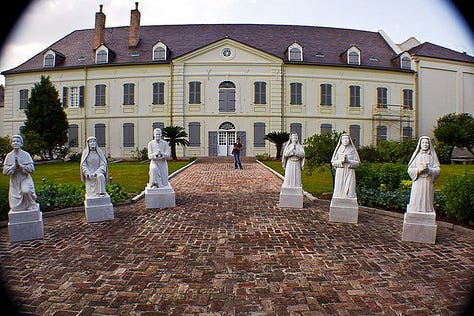
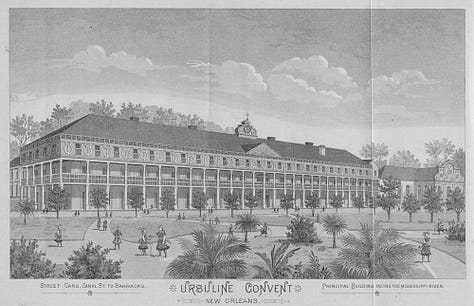
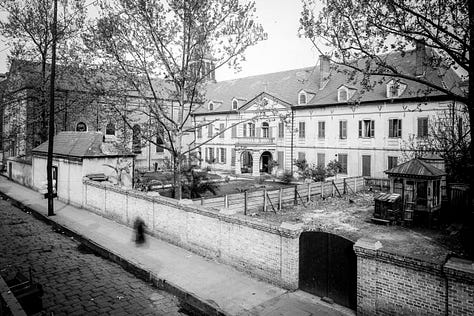
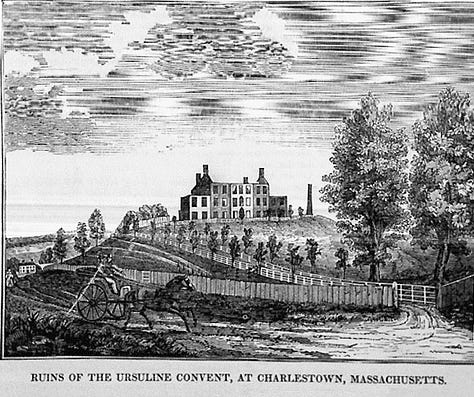
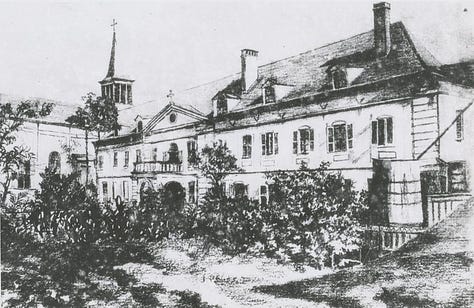
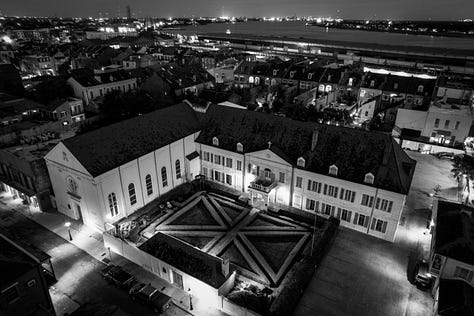
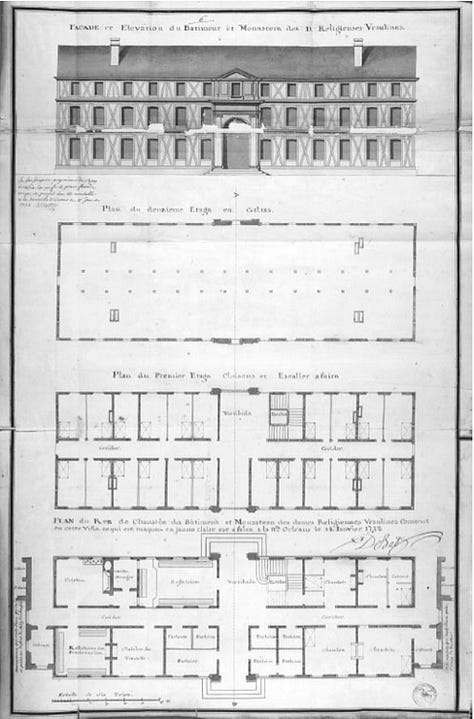


A Lasting Legacy: The Ursuline Nuns & the Casket Girls
The story of the Ursuline nuns is an integral part of the Casket Girls narrative. These nuns provided guidance, education, and stability during a time when New Orleans was still finding its footing as a new colony. Their convent was not only a place of worship but also a beacon of learning, a symbol of hope, and a testament to the strength of these women who braved the unknown to build a better future.
As we explore the tales of the Casket Girls and the legends surrounding them, it’s essential to remember that history encompasses more than just a collection of facts. It’s a story about the people who lived through it, the buildings they inhabited, and the mysteries they left behind. With their dedication and courage, the Ursuline nuns remain a vital thread in this tapestry of New Orleans’ history—one that continues to captivate us centuries later.
Separating Fact from Fiction: The True Story Behind the Casket Girls
As we’ve journeyed through the legends, myths, and historical accounts surrounding the Casket Girls, it’s time to set the record straight and connect the dots between what’s fact and what’s been sensationalized over the centuries.
The Arrival of the Casket Girls: Facts vs. Fiction
The Casket Girls arrived in Biloxi in 1721, six years before the Ursuline nuns reached New Orleans. Contrary to popular belief, the two stories did not connect as the legend suggests. By the time the Ursuline Convent was established in 1752—three decades after the Casket Girls had settled into their married lives—the girls were already well-established in Louisiana society. Although the convent is often rumored to have been the girls’ home, it didn’t exist when they arrived, making that part of the story purely fictional.
Nevertheless, one rumor does contain some truth. New Orleans was a refuge for criminals, vagrants, and outcasts, serving as a makeshift penal colony for France in the 18th century. While the city’s early days were steeped in crime and chaos, this aspect of its origins is a tale for another time.
The “Caskets” That Weren’t Coffins
Now, let’s clarify the confusion surrounding the “caskets.” Contrary to some legends, the Casket Girls weren’t hauling around coffin-like trunks. Here, “casket” or “cassette” refers to a small trunk or suitcase for carrying their belongings. Over the years, the term “casket” evolved, and by the 19th century, it had begun to denote a coffin in certain areas—especially in the United States. However, the girls’ “caskets” resembled travel bags, far removed from the macabre image of coffins. So, let’s put that myth to rest once and for all: the Casket Girls didn’t carry coffins with them.
Illness & the Challenges of Colonial Life
The Casket Girls’ journey across the Atlantic and their settlement in Louisiana were filled with hardships, but the illnesses they encountered weren’t unusual for the era. Due to its swampy terrain, subtropical climate, and inadequate nutrition, New Orleans served as a breeding ground for disease. This was a harsh reality of the colonial period, where sickness often accompanied any transatlantic voyage. The rumors of illness spreading among the Casket Girls are rooted in historical fact, although they weren’t confined to their group alone. Illness was simply a part of life in a city still trying to navigate its challenging environment.
The Mystery of the Ursuline Convent’s Attic Shutters
The Ursuline Convent, built long after the arrival of the Casket Girls, carries its own set of eerie legends. The attic shutters, in particular, have been the focus of much speculation. Unlike most historic buildings that allow attic windows to remain open for ventilation, the Ursuline Convent’s shutters are securely sealed. Over the years, locals have reported strange occurrences: shutters mysteriously flung open during storms only to close quickly again, and ghostly faces appearing in the attic windows. Some visitors claim to have felt unseen eyes watching from above.
While these stories enhance the convent’s supernatural allure, the truth behind the sealed shutters remains a mystery. Whether it’s a matter of preservation or something more, the legend continues to captivate the imaginations of those who walk past the convent today.
Unraveling the Threads of History & Myth
The tale of the Casket Girls is an intriguing mix of fact, fiction, and folklore. While we’ve debunked some fantastical aspects, the legend endures, fueled by the city’s rich cultural history and deep connections to the supernatural. As we’ve uncovered the layers of this story, it’s evident that the truth behind the Casket Girls is just as captivating as the myths surrounding them. Ultimately, the legend of the Casket Girls reminds us how history and imagination often intertwine, creating narratives that last long after the facts have faded into the mists of time.
A Haunting Twist on the Legend: The Casket Girls Reimagined
If you’ve made it this far, congratulations! You’re in for an exclusive treat. As a reward for sticking with me through this journey, I’m unveiling Marita Cradle’s hauntingly reimagined version of the Casket Girls legend.
Now, sit back and let the eerie legend unfold…
The year was 1721, the time of New Orleans's infancy. A great need for marriageable women to help colonize Louisiana was burdening the governing forces. Thus, 24 young girls were selected from a hospital in France, la Salpêtrière, a boarding facility with a suspicious reputation. It was a home for orphans, prisoners, and the mentally insane. Between 14 and 17 years of age, the girls who were chosen had been raised, many of them from birth, in the walls of la Salpêtrière. While it was not at their discretion whether they would stay in France or embark on the journey to New Orleans, heading toward a questionable future, one might think the chance for any adventure out of the walls of la Salpêtrière would have been a welcome one.
Uncertain of their fate, the girls were put under the chaperonage of Sister Gertrude, also of la Salpêtrière. She was said to have ruled with an erratic nature. Her charge was to keep the girls safe on the ship and behind lock and key during evening hours, so they would not be deflowered. La Salpêtrière was a dark, gruesome place where historically, not just orphans, the mentally ill, and the insane were housed, but also diabolical creatures were rumored to have been held captive there when necessary. In addition to ensuring the Casket Girls had safe passage, the sister, a creature of sorts herself, was to dispose of, while at sea, a very dangerous passenger. The girls traveled with large trousseaus, also referred to as caskets at the time. Sister Gertrude traveled with a casket of her own, you see. It was the casket of one very dangerous vampire.
Bienville writes of a trick Sister Gertrude, the girls' chaperone, played during the voyage. The sister was clearly jealous of the young maidens and the attention they received, adored by all they met. The sister might have released that creature in the girls' locked chambers on one evening at sea. Perhaps the sister made a pact with the vampire, whom she was supposed to dispose of. It is rumored that one girl said just before she went dizzy at night that she had seen a small black cat in their chambers. Just thereafter, she was visited by a dark figure who seemed to entrance her, and then mysteriously, she went faint. The girls were all reported to be weak from poor nutrition, but their weakness have come from the first bite of the vampire? Perhaps night after night, they were being visited by the creature who was slowly turning these girls into prisoners of darkness at Sister Gertrude's direction.
Meanwhile, the girls were kept under lock and key at night. During the day, when others roamed on deck, the girls were now nowhere to be seen. However, the dark, sealed quarters of the ship certainly made it possible for nocturnal creatures to be quite safe during daylight hours. Many passengers were hit by illness during the journey, some actually dying. While not thought of as unusual at the time, many now question whether those passengers weren't fated at the hands of something sinister. Could they have been nourishment for the vampire and the maidens who were under its spell?
Sister Gertrude was chagrined as the girls seemed to become more and more beautiful during the voyage. Once they reached Louisiana, Sister Gertrude was the sole witness as each girl was quickly wed, all by night. However, she was then shipped immediately back to France, quite in her favor, as she avoided any consequences of her actions. It is said that there is no record of these girls ever having made it to New Orleans. However, over the years, there was much illness in the city of New Orleans during these times, and that is the primary reason the Ursulines were sent to the city. It is very likely that once the girls accepted their new existence, they made their way to this city known for its sinister side. It was perfect for a creature of the night. They could feast on the prisoners, prostitutes, and vagrants, as who would be missing them?
Sister Mary Hachard, the youngest of the Ursulines, wrote five long letters to her father during her travels to New Orleans, in one of which she makes a point of mentioning a small cat. She wrote, “We also took a pretty little cat that wanted to be a part of our community, taking for granted that it could find little mice and rats in Louisiana just as in France.”
Well, it is rumored that the king found out about Sister Gertrude’s shenanigans during the voyage to Louisiana and now feared for the safety of the people of Louisiana at the hands of the vampire maidens. However, it was agreed that it was no fault of the girls themselves what they had become, so the order was made that Sister Gertrude would sail with the Ursulines undercover. Sister Gertrude was never seen on the ship La Baleine; there was only a small pretty cat. Sister Gertrude had been given a little rope but had greatly taken advantage of the freedom the king afforded her. Now found out, perhaps her punishment was not to scurry for little mice and rats, but sent to the Ursulines in cat form, the sister was made to travel back to New Orleans and one by one, find and capture the Casket Girls. She was to bring them under the care of the nuns until the convent was built, and there they would be housed under lock and key for eternity, under Sister Gertrude’s eternal observation. It was, after all, at her hand that the horror of the girls’ fate had transpired.
The Casket Girls would indeed remain in the convent under Sister Gertrude’s perpetual patrol. However, the girls would also receive the care of the Ursulines. They would be educated, given love and spiritually nurtured to recapture whatever humanity they were capable of in their current situation. The nuns were driven to help women of all types and certainly those who had been the victims of a cruel, immoral, and immortal joke.
Once they arrived in New Orleans, the Ursulines were made privy to the vampire maidens. The girls were brought one by one to the house on Bienville Street. Sister Gertrude anxiously awaited the convent’s security and convenience to its hospital. She was currently forced to hunt daily around town, directing rats to the maidens to feast on for the blood that was necessary for their survival.
Finally, the time came in 1735 when the first convent was built. It was quite a predicament now to get the vampires from the house on Bienville Street to the convent without notice. It was decided that the cloistered nuns, rather than travel quickly in buggies to the convent with caskets in tow, would make a statement of their presence in New Orleans with a procession from the Bienville house to the convent. Their procession, with music and costumes, would drive attention away from the several caskets they traveled with behind the parade, concealed under a canopy.
The vampires were then held captive on the third floor and fed the blood of the ill, which worked for their circumstances. Later, when the convent was rebuilt in 1752, they were only afforded an attic. Some of them had attempted on more than one occasion to escape, so it was decided an attic could be kept more secure. In addition, a special room was built, for the protection of the nuns, where the vampires could be punished in seclusion when necessary, until they were once again brought to reason. It is said that occasionally, one of the girls would go mad to the cloister, which was their eternal prison. The nuns were then forced to secure the vampire in this room. It is the only room in the attic with a brick floor, and heavy chains are secured to the beams. There is a double door so that the nuns were not forced to enter the room but could simply toss rats in for the girls to feed on. There in the third-floor attic they stay under the protection of the church and the archdiocese.
Many say that when they wander past the convent at night, they feel eyes peering deep into their souls. These are the eyes of the maidens who were robbed of their humanity and then their freedom at the hands of one sour spinster, Sister Gertrude - centuries of anger, desire, confusion, and sadness held captive in one attic. A small cat is said to be seen now and then, roaming the convent grounds. Sister Gertrude’s curse remains as guardian of the Casket Girls.
Reflecting on the Legend: The Casket Girls & Their Place in New Orleans Folklore
So, what do you think of this reimagined version of the Casket Girls legend? Could it be the next big twist in New Orleans folklore? Share this story with your friends, family, and across your social media - let’s see if we can breathe new life into this captivating tale.
But now, I’d love to hear from you! What’s your take on the Casket Girls of New Orleans? Does the historical record live up to the legend, or do the myths add a deeper layer to the story? Please share your thoughts in the comments.
If you’re eager to learn more about the Casket Girls, explore the sources in the next section of this post. And if you’re in the mood for more fascinating stories, check out my other posts! Remember, history often holds more mystery than we expect, so stay curious and be safe out there. After all, you never know what might be hiding in the shadows.
References
"The Casket Girls and Vampires of New Orleans" by Folklore Thursday - https://folklorethursday.com/halloween/the-casket-girls-and-vampires-of-new-orleans/
"New Orleans Vampires - History and Legend" by Marita Woywod Crandle - https://www.feelthebite.com/products/new-orleans-vampires-history-and-legends-by-marita-woywod-crandle
"The Truth About the Casket Girls in New Orleans" by Ghost City Tours - https://ghostcitytours.com/new-orleans/ghost-stories/truth-casket-girls/
"The Vampire Murders at Ursuline Convent 1978" by Unexplained Mysteries - https://www.unexplained-mysteries.com/forum/topic/237485-the-vampire-murders-at-ursuline-convent-1978/
"Crimes and Witch-Demeanors" podcast episode "The Casket Girls and Vampires of New Orleans" - https://music.amazon.co.jp/podcasts/9f98725a-d652-40ad-af25-f6eb395f871e/crimes-and-witch-demeanors
Boomer, L. (2022, July 8). The Casket Girls - Women & the American Story. Women & the American Story. https://wams.nyhistory.org/settler-colonialism-and-revolution/settler-colonialism/casket-girls/#:~:text=Of the 258 women shipped,trunks%2C they brought with them.
Crandle, M. W. (2017). New Orleans Vampires: history and legend. Arcadia Publishing. https://amzn.to/4i8AcO2
GOULD, V. (2018). Bienville’s Brides: Virgins or Prostitutes? 1719-1721. Louisiana History: The Journal of the Louisiana Historical Association, 59(4), 389–408. https://www.jstor.org/stable/26564828
300 Unique New Orleans Moments: “Casket Girls” Shipped to New Orleans for Molding into “Refined Citizens.” (2017, October 23). The Advocate. Retrieved July 20, 2023, from https://www.theadvocate.com/new_orleans/entertainment_life/tricentennial/300-unique-new-orleans-moments-casket-girls-shipped-to-new-orleans-for-molding-into-refined/article_12a9b03a-5214-11e7-891d-b7b98364a3d0.html
Dubey, S. (2022). Factual origins of myths. International Journal of Social Science and Human Research, 05(10), 4491–4493. https://doi.org/10.47191/ijsshr/v5-i10-11
Curtis, B., Kirtley, P., & Lovelace, T. Vampires, Werewolves, and Zombies: Building a Classroom Community Based on Louisiana Folklore.




